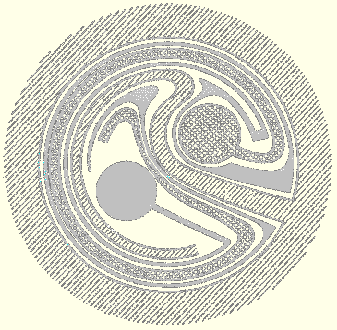![]()
Topological Curiosities
There are three plane regions that share exactly the same boundary.
Topology disregards many usual properties of objects such as area, length, having corners, being straight, etc. Topology is only concerned with those properties that remain invariant, i.e. do not change, under continuous transformations which in the physical (intuitive) world comprise distortion and stretching. Now, distortions and stretchings are assumed to be reversible. Thus squeezing and shrinking are also topological transformations while gluing, having tearing as the reverse transformation, is not topological.
Focusing on simple properties that shun measurements might create an impression that topology is preoccupied with the most trivial things. Actually, basic or fundamental will be, by far, a better Description for the subjects of the topological study. Topology includes the study of knots, one-sided surfaces and dimensionality of curves and surfaces among a variety of other things. Far from dealing with obvious, the topological research discovered things even more marvelous than the plane filling curves. One of these is an example of three plane regions all sharing exactly same boundary. Just for the comparison sake, a polygon separates the plane into two regions: its interior and exterior. The two share the boundary which is the polygon itself. Clearly there is no room for a third region. Thus the promised example will likely look weird. The idea of such a construction has been conceived by the Dutch mathematician Brouwer while the example below is due to the Japanese mathematician Yoneyama. It's best described in the narrative form.
Imagine an island in the sea and on it a cold and a warm lake. The following work program is to be carried out on the island.
In the course of the first hour canals are to be dug, on from the sea, one from the warm lake, and one from the cold lake, in such
a way that neither salt and fresh nor warm and cold water come into contact with one another, and so that at the end of the hour every
point of land is at a distance of less than one mile from each kind of water (i.e. salt, cold, and worm). In the next half an hour,
each of the canals is to be continued so that the different kinds of water remain separated , and at the end of the work the distance
of every point from each kind of water is less than one half-mile. In the analogous manner the work continues for the next 1/4 hour, and
then 1/8 hour, and so on. At the end of the second hour (recall that

The result begs explanation especially in view of the definition of boundary points.
There are many more wonderful and unexpected results
Reference
- P. Alexandroff, Elementary Concepts of Topology, Dover Publications, NY, 1961
- S. Barr, Experiments In Topology, Dover Publications, NY, 1989
- B. R. Gelbaum and J. M. H. Olmsted, Counterexamples in Analysis, Holden-Day, 1964
|Contact| |Front page| |Contents| |Did you know?| |Geometry|
Copyright © 1996-2018 Alexander Bogomolny73569855
